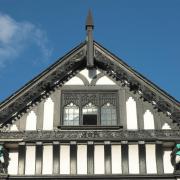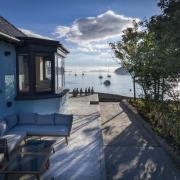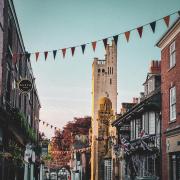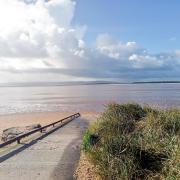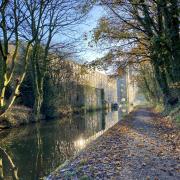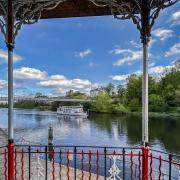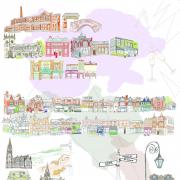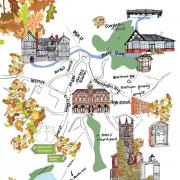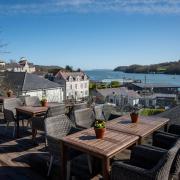Stephen Roberts takes a history tour of his top 10 North Walian treasures
1. Caernarvon (*Cadw)
I’m starting in a place of ancient fortification, Caernarvon, where the Romans had a fort. The first castle dated to around 1090 though and was of the timber motte and bailey persuasion. Having conquered North Wales, Edward I began building today’s monster in 1283, an undertaking that would cost some £1¼ million in today’s money, including the town walls. It’s fair to say any subsequent work has not really changed the overall conception. The first English Prince of Wales, Edward of Caernarvon (the future Edward II) was born here in 1284. Both Prince Edward (the future Edward VIII/Duke of Windsor), and Prince Charles were invested at the castle, while the Royal Welsh Fusiliers Museum is a highlight of any visit. cadw.gov.wales/visit/places-to-visit/caernarfon-castle

2. Chirk (National Trust)
One of the marcher (border) fortresses, Chirk is sited where Wales and England meet, the land here being granted to Roger Mortimer (1231-82), a trusted lieutenant of Edward I, who began building the current castle from c.1274. Chirk seems not to have remained in the same family for any great length of time until it was sold to Sir Thomas Myddelton (1550-1631) in 1595, staying in the family until 1981 when it was transferred to the National Trust. During the English Civil War, the castle was captured by the Royalists who held Chirk until 1646 when, realising that the game was up for the Royalist cause, ‘stole all privately away’ (scarpered). A modern highlight is the reopening of the gardens for winter snowdrops. nationaltrust.org.uk/chirk-castle

3. Rhuddlan (Cadw)
This place has long been important as it commands a crossing of the Clywd with the first castle a Norman motte and bailey of c.1073. Edward I was prominent again, using Rhuddlan as a base for his conquest of Wales and today’s castle dates to his time (c.1277), his works including diverting the Clywd so the castle could be supplied from the river. Edward promised the Welsh he would present them with a ‘Prince born in Wales’ which would, of course be his own son. Where this ‘presentation’ occurred has been disputed with some, quite naturally, believing it must have taken place at Caernarvon while others think it may have been at the older castle of Rhuddlan. The castle was slighted during the English Civil War, so is ruinous today.
cadw.gov.wales/visit/places-to-visit/rhuddlan-castle

4. Denbigh (Cadw)
The castle at Denbigh, which stands high up in the centre of town, was built c.1282. Several of the castle’s owners suffered the grim fate of execution and Denbigh later saw action during both the 15th-century Wars of the Roses, when it changed hands more than once, and the 17th-century English Civil War being captured by the Parliamentarians in October 1646 following a six-month siege. King Charles I had visited the castle after his defeat at the Battle of Rowton Heath the previous September, which prevented him from lifting the siege of Chester. Denbigh was another castle, like Rhuddlan, to be slighted before the Restoration of the Monarchy in 1660, so is ruinous today yet still one of Wales’s most interesting castles.
cadw.gov.wales/visit/places-to-visit/denbigh-castle

5. Beaumaris (Cadw)
Beaumaris joins Caernarvon and two other North Walian castles, Conwy and Harlech, in comprising a World Heritage Site. When the Welsh attacked Caernarvon in 1294 Edward I decided to fortify the local defences by building another castle across the Menai Strait on the Isle of Anglesey. What he produced remains the finest preserved concentric castle in Britain although it would not be as big or lofty as intended as the troublesome Scots and forced economies saw the works petering out in the 1320s with the upper storeys of the two gatehouses and Great Hall never completed. The Royalists surrendered the castle in 1646 but luckily, Beaumaris avoided the fate of Rhuddlan and Denbigh and is in good condition. cadw.gov.wales/visit/places-to-visit/beaumaris-castle

6. Conwy (Cadw)
Conwy not only has one of North Wales’s great four castles but also an unbroken 1.3km of town walls. The earlier castle of Deganwy, which previously glowered over the crossing of the Conwy estuary, was cannibalised, with the stone used to build Edward I’s new Conwy Castle, completed in c.1287 and costing even more than Caernarvon – in today’s money, some £2 million. The castle saw action during the English Civil War with firstly the town captured for Parliament in August 1646 then the castle holding out until November when the Royalist garrison marched out ‘on favourable terms’. Conwy fell into disrepair after the Restoration but received a Victorian makeover and is available for venue hire. cadw.gov.wales/visit/places-to-visit/conwy-castle

7. Ruthin (Ruthin Castle Hotel)
Ruthin is a hefty, mostly Victorian hotel these days, however, the first reference to a castle here was in 1282 when the Welshman Llewellyn the Last lost it to the Englishman Reginald de Grey, another lieutenant of Edward I. De Grey transformed what had been a modest Welsh fortress into another mighty English castle, which was later attacked by Owain Glyndwr (1400), but held out under a subsequent Reginald de Grey. Ruthin would later be owned by the same Sir Thomas Myddelton we met at Chirk. The castle was taken by Royalists, besieged and surrendered, with the usual slighting following. The new castle was erected in 1849 and is today a hotel and spa. ruthincastle.co.uk

8. Harlech (Cadw)
The fourth of the great North Walian castles that comprise the World Heritage Site, Harlech was, without doubt, the most spectacularly sited of Edward I’s castles, standing on a crag looking down on the sea. Built in the 1280s it was attacked by the Welsh more than once and actually taken by Glyndwr in 1404 before it was recaptured by the English in 1408. The legendary ‘Men of Harlech’, immortalised in song, date to the Wars of the Roses when the castle held out for the Lancastrians until August 1468. During the English Civil War Harlech was garrisoned for the king but finally surrendered to Parliament in 1647 yet avoided the fate of many other Welsh castles, in not being slighted. Today the site is available for hire for events, exhibitions and filming. cadw.gov.wales/visit/places-to-visit/harlech-castle

9. Criccieth (Cadw)
Another native Welsh castle that was later strengthened by the English (c.1290), Criccieth commands Cardigan Bay. Later, Criccieth would be owned by the famed Black Prince, his constable being Sir Hywel ap Gruffydd, who took few prisoners on the battlefield as attested by his nickname of Howel of the Battle axe. Glyndwr was here too, burning and knocking the castle about in 1404, the same year as he took Harlech. The castle remained inhabited until the early-17th century though, with a quaint tradition that the meat was carved with old Hywel’s battle axe. The castle ruins were the subject of a painting by Joseph Mallord William Turner, dated around 1836. cadw.gov.wales/visit/places-to-visit/criccieth-castle

10. Dinas Bran (Denbighshire Council/assisted by Cadw)
And finally, one of Wales’s most spectacular castles, Dinas Bran, which looks down from its lofty position on Llangollen and was probably built in the 1260s on the site of earlier fortifications. If you like tragic love tales then visit Dinas Bran, which was the home of Myfanwy Fechan in 1390. The story goes that she awaited the perfect suitor who could compose and sing lyrical poetry that praised her beauty. A penniless young bard captivated Myfanwy with his harp and voice and appeared to have won her heart only for the demanding lady to choose another, who was both handsome, and wealthy. By the reign of Elizabeth I the castle was already being described as a ruin.
*CADW: the Welsh Government's historic environment service
10 more North Walian castles
Dolbadarn (Cadw) – lofty round tower which guards the Llanberis Pass, Snowdonia
Dolwyddelan (Cadw) – Welsh stronghold captured by Edward I in 1283
Gwydir (Privately owned) – fortified manor house dating to c.1500
Holt (Wrexham County Borough Museum) – open-access site reopened to the public in 2015
Ewloe (Cadw) – Welsh-built castle which sits in a hollow amid deep woodland
Flint (Cadw) – scene of the meeting between Richard II and his deposer, Henry Bolingbroke
Hawarden (Privately owned) – medieval & 18th century castles, the latter home to Gladstone
Castell Y Bere (Cadw) – built by Llywelyn the Great c.1221 at the foot of Cader Idris
Deganwy (Privately owned) – castle abandoned when Conwy was built by Edward I
Penrhyn (National Trust) – 19th-century castle built on the site of a medieval fortified manor
READ MORE: 17 of the prettiest castles in England






